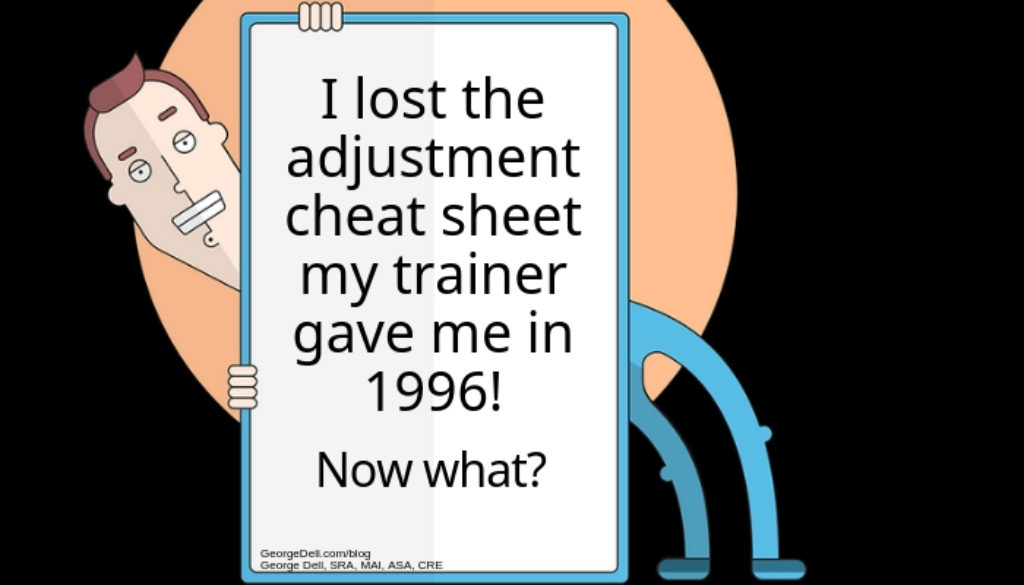We’re told to “support” our adjustments. We hear words like “prove” your adjustments. . . as if there were some magic formula which can give an exact, correct, and absolutely true number.
It used to be so easy. . . Our trainer gave us a sheet with the “right” adjustments. Simple.
USPAP Standards Rule 1-1 says we must be aware of, understand, and correctly employ recognized methods and techniques. What are they? Who recognizes them? How do I apply them?
So, what are these methods and techniques? Let’s look.
In The Appraisal of Real Estate (ARE) p.46, it says: “Qualitative analysis techniques may also be applied for elements of comparison for which quantitative adjustments cannot be developed.” So, it seems the very first reference in the ARE says some adjustments cannot be quantitatively developed!
The next reference (ARE) p.91says, “…with supportable adjustments to recent comparable data providing the most credible evidence of market value.” So now we read that making adjustments which are “supportable” is enough (but there is no need to actually support or calculate or estimate or reckon or imagine such a number – should be enough to be “credible” (worthy of belief). “I could support it if I really wanted to!”
Then on page 275, “Statistical Analysis in Appraisal”, says:
“Statistical techniques like regression analysis have become accepted tools in the application of the approaches to value. In fact, the application of regression analysis to comparable sales data is a natural and obvious extension of the traditional analysis of differences in the sale prices of comparable properties in the adjustment process. A simple linear regression model can be used to estimate the influence of a particular characteristic with significant statistical reliability when an adequate supply of data is available.”
On page 377, The Sales Comparison Approach, it states clearly that an adjustment can be determined!
“Similarly, in applying the sales comparison approach appraisers often analyze conclusions derived in the other approaches to determine the adjustments to be made to the sale prices of comparable properties.”
On page 388, it says “Appraisers analyze market data using mathematical applications to derive quantitative adjustments.”
On pages 398-404, it tells us how to adjust. Here are the methods explained:
- Paired data: Compare two properties/transactions which are exactly the same except for the one feature.
- Grouped data: Compare comparable sales grouped by an “independent variable”. (It examples a time adjustment using date of sale – which exhibits the same “data discarding” issue as has been found in the GSEs residential form 1004mc, which give wrong results or in the wrong direction.)
- Secondary data: “This technique makes use of data that does not directly pertain to the subject or comparable properties.”
- Statistical: “An appraiser can develop a series of adjustment factors to control for different tract sizes by creating a simple linear regression model and then use the results of the regression analysis as a means of inferring the size adjustment for properties within the range of the data. If a reasonable pattern emerges, the model can be applied to a group of sales with differing land sizes to test its accuracy, although the process might also demonstrate that the indicated adjustments are incorrect.”
- Scenario: “Scenario analysis is a form of modeling in which the conditions created by future events are forecast to test the probability or correlation of alternative outcomes.” Got it.
- Graphic: “Use grouped data to illustrate variations in the elements of comparison.”
- Cost Related: “In cost analysis, adjustments are based on cost indicators such as depreciated building cost, cost to cure, or permit fees.”
- Capitalize income differences: “when the income loss incurred by a comparable property reflects a specific deficiency in the property”. (This presumes identical in all other respects.)
- Qualitative: “recognizes the inefficiencies of real estate markets and the difficulty of expressing adjustments with mathematical precision.” (Does this imply that quantitative methods are mathematically precise?)
- Trend: “In the context of statistical theory, trend analysis is often defined as analysis of a time series. In the context of sales comparison, the term simply refers to the use of statistical techniques to make comparisons of variables other than time.”
- Ranking: “The comparable sales are ranked according to overall comparability or by some other element of comparison so that the relative position of each comparable sale to the subject property is clear. Specific value trends can thereby be established for elements of comparison that are market-sensitive, and those that show no discernible or reasonable trends will be discarded.”
There you have it. Hopefully this clears it all up.
Or . . .
References are to The Appraisal of Real Estate, 14TH ed., Appraisal Institute, Chicago, 2013
© You are free to share, copy and redistribute, transform, and build upon for any purpose, except for commercial use. Attribution – You must give appropriate credit and may not restrict others. While I wish to help spread the benefits of the copyrighted terms and materials for the benefit of the valuation community, I wish to restrict those who would monetize or misinterpret or misapply the concepts as written. My experience has been that commercial users are the greatest violators of the open-source, creative commons principles of knowledge sharing.
Thus, we request attribution, share-alike, and non-commercial use only.
